Related Research Articles

Yazdegerd III was the last Sasanian King of Kings of Iran from 632 to 651. His father was Shahriyar and his grandfather was Khosrow II.
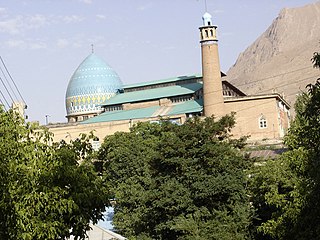
Damavand is a city in the Central District of Damavand County, Tehran province, Iran, and serves as capital of both the county and the district.
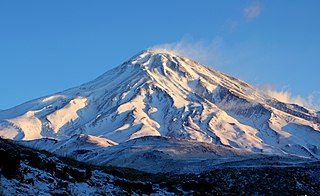
Mount Damavand is a dormant stratovolcano and is the highest peak in Iran and Western Asia, the highest volcano in Asia, and the 3rd highest volcano in the Eastern Hemisphere, at an elevation of 5,609 metres (18,402 ft). Damāvand has a special place in Persian mythology and folklore. It is in the middle of the Alborz range, adjacent to Varārū, Sesang, Gol-e Zard, and Mīānrūd. It is near the southern coast of the Caspian Sea, in Amol County, Mazandaran Province, 66 km (41 mi) northeast of the city of Tehran.
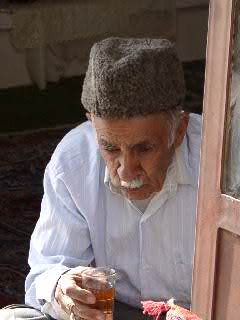
Kilan is a city in the Central District of Damavand County, Tehran province, Iran.

Damavand County is located in Tehran province, Iran. The capital of the county is Damavand.
Iran (Persia) has had numerous capital cities and royal centers throughout its history.

Azarmidokht was Sasanian queen (banbishn) of Iran from 630 to 631. She was the daughter of king (shah) Khosrow II. She was the second Sasanian queen; her sister Boran ruled before and after her. Azarmidokht came to power in Iran after her cousin Shapur-i Shahrvaraz was deposed by the Parsig faction, led by Piruz Khosrow, who helped Azarmidokht ascend the throne. Her rule was marked by an attempt of a nobleman and commander Farrukh Hormizd to marry her and come to power. After the queen's refusal, he declared himself an anti-king. Azarmidokht had him killed as a result of a successful plot. She was, however, killed herself shortly afterwards by Rostam Farrokhzad in retaliation for his father's death. She was succeeded by Boran.
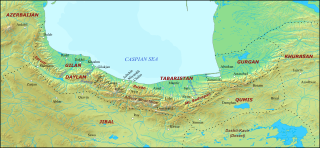
Tabaristan or Tabarestan, was the name applied to a mountainous region located on the Caspian coast of northern Iran. It corresponded to the present-day province of Mazandaran, which became the predominant name of the area from the 11th-century onwards.

Abali is a city in Rudehen District of Damavand County, Tehran province, Iran, and serves as the administrative center for Abali Rural District.
The Daylamites or Dailamites were an Iranian people inhabiting the Daylam—the mountainous regions of northern Iran on the southwest coast of the Caspian Sea, now comprising the southeastern half of Gilan Province.
Bahman Jādhūyah/Jādūyah, or Bahman Jādhawayh was an Iranian general of the Sasanians. He is mostly known to have led the Sasanians to victory against the Arabs at the Battle of the Bridge. The Arab Muslims referred to Bahman as Dhul Hājib. He had a reputation for being anti-Arab. He is often confused with Mardanshah, another Sasanian general.
Mardanshah was a Sassanian Persian general, the Arabs referred him to as Dhul Hājib as was Bahman Jadhuyih.
Mardanshah was a 7th-century Sasanian prince. He was the son of the Sasanian king (shah) Khosrow II and Shirin, and was the preferred successor of the Sasanian Empire. He was later killed along with his brothers and half-brothers by his half-brother Kavad II in 628.
Siyavakhsh was an Iranian aristocrat from the House of Mihran who was descended from Bahram Chobin, the famous spahbed of the Sasanian Empire.
Masmughan was a Sasanian title that existed in the 7th century, probably equivalent to governor of a district or a region.

The Masmughans of Damavand were a local dynasty, which ruled Damavand and its surrounding areas from ca. 651 to 760. The founder of the dynasty was a Karenid named Mardanshah of Damavand.

Damavand College was founded in 1968 as a private institution of higher learning for women and run by an international community and by American Presbyterian Missionaries. In 1974, it became a public college, offering a four-year intercultural program in liberal arts.
Khuzestani Arabs are the Arabic speaking inhabitants of the Khuzestan province and the largest Arabic speaking community in Iran which primarily reside in the western half of Khuzestan. The capital of Khuzestan is Ahvaz. As of 2010, Khuzestani Arabs numbered around 1.6 million people.
Mansur ibn al-Mahdi was an Abbasid prince, son of Abbasid caliph al-Mahdi, brother of caliph al-Hadi and Harun al-Rashid. Mansur was governor of Syria during his nephew caliph al-Amin's reign.
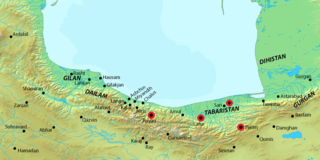
Tabaristan uprising was a series of rebellions and battles of indigenous Zoroastrian population of Tabaristan against the Abbasid Caliphate, led by local Spahbeds which occurred between 784 and 804. A few years after Spahbed Khurshid's suicide and the annihilation of the Dabuyid dynasty, as dissatisfaction with the actions of the Abbasid caliphs grew, people turned to the Qarinvand dynasty Spahbed, Wandad Hurmuzd and asked him to lead their uprising. After deliberation with Spahbeds of other dynasties such as Baduspanids, Bavandids and Masmughans of Damavand, he accepted people's request. From then Sharwin I was like king of Tabaristan and Wandad was his warlord. On a predetermined day, they raised a great rebellion against the Abbasid caliphate, and the people of Tabaristan and Ruyan attacked the garrisons on this day and killed the Arab soldiers. Historians refer to this day as "the day when Tabaristan was emptied of Caliph's agents" and report that 20,000 people were killed.
References
- ↑ "Maṣmug̲h̲an." Encyclopaedia of Islam, Second Edition. Edited by: P. Bearman, Th. Bianquis, C.E. Bosworth, E. van Donzel, W.P. Heinrichs. Brill Online, 2013. Reference. 30 November 2013 <http://referenceworks.brillonline.com/entries/encyclopaedia-of-islam-2/masmughan-COM_0702>
- ↑ Pourshariati (2008), pp. 253